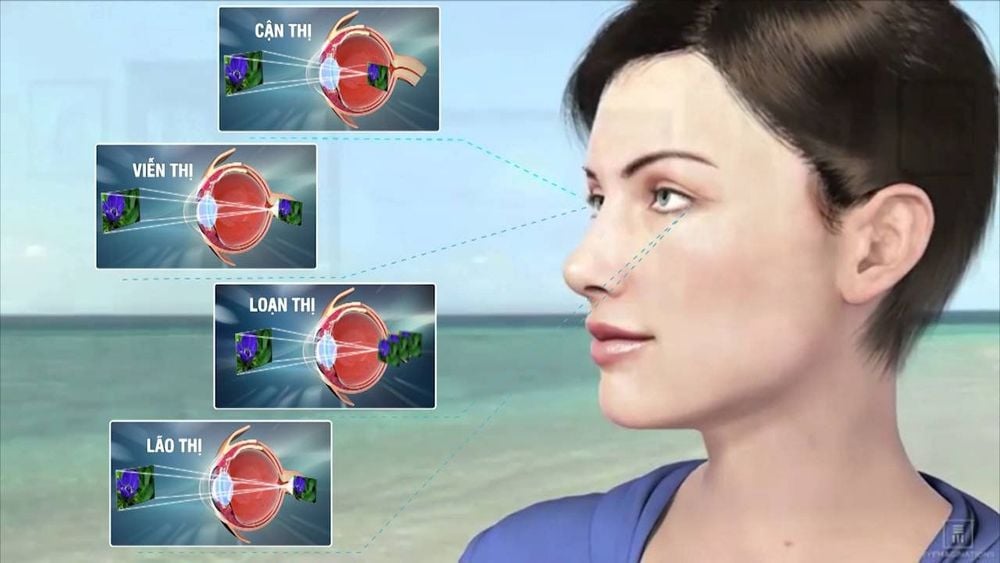This is an automatically translated article.
Eye refraction is one of the most common eye problems that can appear at any age. Refractive errors can affect vision, causing people with the disease to have blurred vision, limiting their ability to see.
1. What is a refractive error in the eye?
Eyes are one of the important senses of the body, allowing us to perceive the shape, color and size of the surrounding objects.
Normally, the eye has normal refraction, the light entering the eyeball will focus on the retina to create a sharp image that is transmitted to the cerebral cortex. To be able to produce sharp images, during the adjustment process, the lens needs to change shape so that the image can properly focus on the retina, and this adjustment ability of the lens is better in young people. year old.
Refractive error is a condition in which when we look at something, our eyes cannot focus on the retina, causing us to see the object blurry.
When the eyes have refractive errors, the patient will not see clearly, or have eye strain, or have to squint, may have double vision, twitching of the eyelids and have a significant impact on activities and quality of life. In some cases, people with refractive errors may have strabismus or amblyopia.
Common causes of refractive errors such as:
Congenital, genetic: Many children are born with refractive errors. Usually due to structural abnormalities of the eye such as longer eyeball axis, larger eyes... Injury due to eye trauma: After trauma to the eye area or the eyes are often exposed to UV rays in the sun. Poor living habits: The intensity of using and using the eyes is too great, not allowing the eyes to rest properly and enough. The surrounding environment is like looking at too dark light intensity, often needing to observe objects that are too close. Excessive exposure to artificial light sources: Due to the development of technology, many electronic devices with blue light sources that affect the eyes such as phones, computers, ipads... were born, causing many people to practice spend too much time with it and cause refractive errors. Age: As we age, the ability of the eyes to adjust is less and less, leading to increased eye diseases. In addition to causes related to birth and age, refractive errors in the eyes are completely preventable. Therefore, it is necessary to pay attention to the prevention of diseases to avoid affecting the ability to live, especially for school-age children.

Mắt bị tật khúc xạ sẽ khiến người bệnh gặp khó khăn về thị lực
2. Refractive errors in the eye
2.1 Myopia For people with myopia, the point of convergence of light rays is in front of the retina. Therefore, people with myopia can clearly see objects at close distances, but when looking at objects farther away, they produce blurry images, difficult to perceive.
Signs of myopia can be encountered such as frequently squinting, blinking to see the target clearly, eyestrain, headache, cross-eyed often appear in people with high myopia.
The cause of myopia is due to the refractive force is greater than normal, due to the frequent near vision, the lens is bulging, increasing the curvature of the cornea, thereby changing the refraction of the eye. The cause is related to genetic factors, people who have both parents with myopia have a 20 to 30% chance of being nearsighted, in people who don't have nearsighted parents, this rate is 2.5 %. In addition, a very important cause that can be prevented is daily living habits, people have habits that are harmful to the eyes such as studying, working in an environment with insufficient light, the distance between the eyes and the eyes. Electronic devices are too close, .. the risk of nearsightedness is many times higher than the average person.
When the patient is nearsighted, the patient can be corrected by measures such as wearing glasses suitable for myopia to improve vision, surgery to treat myopia. ..
2.2 Farsightedness When the eye is farsighted, the light entering the eye will focus at the back of the retina, making farsighted people able to see distant objects clearly but have difficulty seeing objects. nearby.
Symptoms of farsightedness may be encountered such as difficulty seeing up close, eyestrain, headaches, feeling dizzy after a period of time having to focus on almost reading...
Causes of farsightedness Vision includes because the eyeball axis is shorter than normal, this is an inborn factor, all babies are born with farsightedness because the eyeball axis is not yet complete, but over time, it will develop according to the body to help children have correct vision, but in some cases this axis does not develop over time and causes farsightedness. In addition, some other causes occur with a lesser rate such as flattened cornea, which is a small curvature of the cornea, patients with corneal scarring,...
Hyperopia is caused by an abnormality in the eye structure, so there is no cure. prevention measures. But glasses or surgery can be used to correct presbyopia.
2.3 Astigmatism Eye with astigmatism means that light rays are focused at many points on the retina, instead of a single point as usual, causing perceived images to be blurred and feel like dizziness. Astigmatism is often accompanied by nearsightedness or farsightedness.
Astigmatism has common symptoms such as blurred images at all distances, appearance of double images, grandmother images of blurred shadows, difficulty seeing in dark conditions, eyestrain, headaches. ..
The common cause is the irregular shape of the cornea, which causes the inability to focus light on the axis; People whose parents have astigmatism have a higher risk of developing the condition.
In addition to genetic causes, astigmatism can also be prevented by taking care of your eyes, by changing bad habits and implementing good habits such as: working in the right lighting conditions, giving Resting the eyes to avoid fatigue, exercising the eyes at break time are all effective in preventing astigmatism.
Like nearsightedness and farsightedness, astigmatism is also treated with measures such as glasses or surgery.
2.4 Presbyopia Is a condition in which the eye can clearly see distant objects but has difficulty seeing objects at a distance. near to. This is a refractive error with symptoms similar to farsightedness but with different causes. Presbyopia is caused by aging of the eyes, the lens cannot adjust, causing disease.
Presbyopia is more common in people who previously had other refractive errors.

Lão thị là một trong các tật khúc xạ ở mắt
3. Notes on refractive errors
To keep your eyes healthy and limit aggravation of refractive errors in your eyes, you should take eye care measures such as:
Need to have regular check-ups to know the extent of your disease, to take corrective measures. Adjust the best fit and use the right glasses for more accurate vision. Protect your eyes from the sun by wearing sunglasses that block UV rays because they accelerate eye degeneration. Prevent eye injury; Wear safety glasses when doing things that pose a risk of eye damage, such as playing sports, painting, or using products with toxic fumes... Healthy diet: Eat plenty of fruits, vegetables, and whole grains. Vegetables contain high levels of substances such as vitamin A and beta carotene. They are important for maintaining good eyesight. Avoid looking too close or too long at electronic devices or reading books. Give your eyes a rest after a period of continuous activity. Exercise your eyes by looking at an object at a distance for nearly 20 minutes continuously, then look at an object at a distance of 6m for 20 seconds. Hopefully, through the article, you know what a refractive error is or what is refractive error and can recognize the signs of the disease, as well as treatment and prevention measures. When there are signs of suspected refractive error, it is advisable to go to the doctor early to limit the risk of rapid aggravation and help improve quality of life.
Please dial HOTLINE for more information or register for an appointment HERE. Download MyVinmec app to make appointments faster and to manage your bookings easily.













